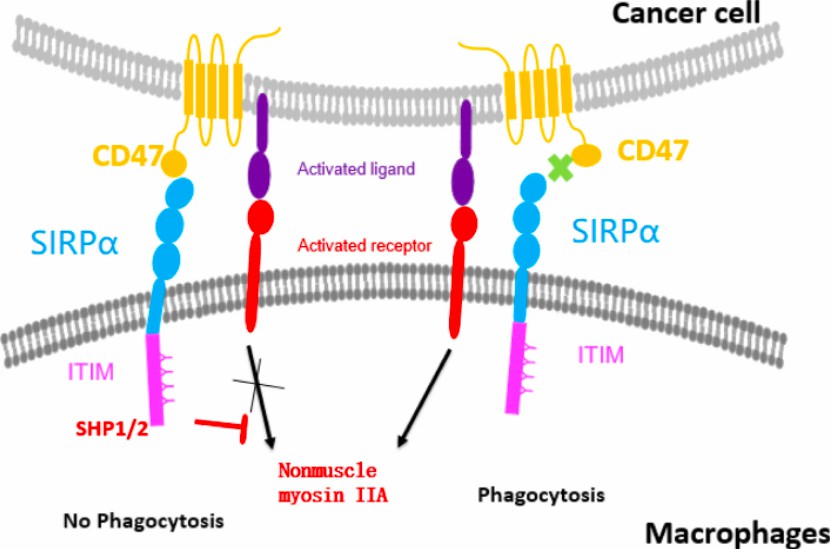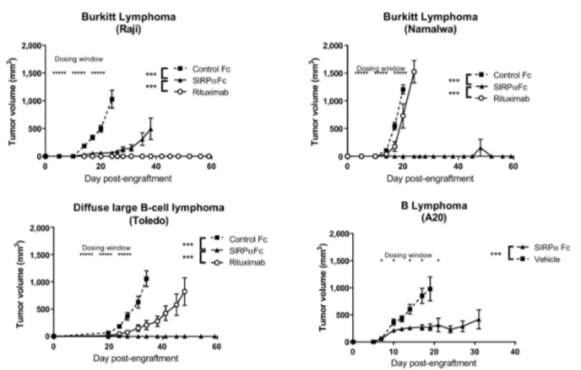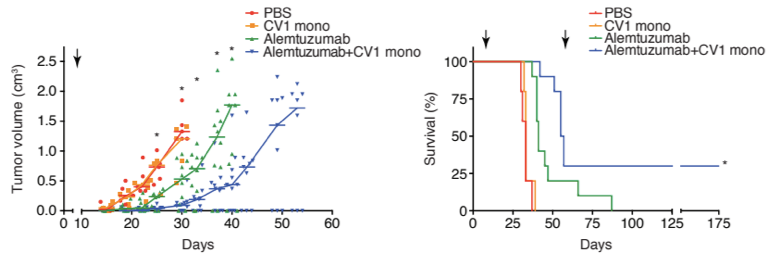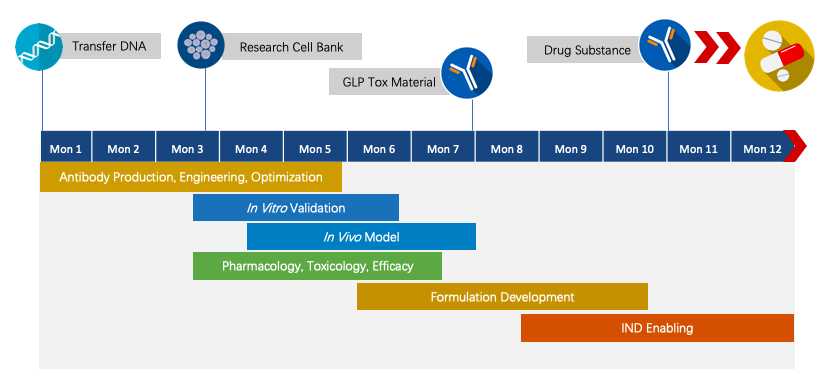About This Program
This program aims to develop anti-folate receptor alpha (SIRPα)-Fc fusion protein for immuno-oncology.
CD47 is a widely expressed transmembrane glycoprotein that plays as the key inhibitory signal in the body. It works by inhibiting phagocytosis through binding to signal-regulated protein alpha (SIRPα) on the surface of macrophages. The CD47-SIRPα interaction may represent an important mechanism on how malignant cells can evade immune-mediated clearance.
We propose to develop a novel innate immune checkpoint inhibitor, SIRPα-Fc, with aims to (i) binding with CD47 on tumor cells to prevent it from transmitting inhibitory signals to macrophages, and (ii) further interacting with the Fcγ receptor (FcγR) expressed by macrophages to enhance phagocytosis.
SIRPα
SIRPα, a cell surface receptor, mainly expressed in monocytes, granulocytes, dendritic cells, and hematopoietic stem cells. SIRPα can also be expressed in bone marrow cells and neurons. Some features are highlighted below:
-
SIRPα significantly inhibits the growth of anchorage-independent cell.
-
Binding of SIRPα to its ligand CD47 can transduce a down-regulated signal that inhibits phagocytosis
-
SIRPα overexpression may, consequently, reduces its reactivity to bind tyrosine kinase ligands, including epidermal growth factor (EGF), platelet-derived growth factor and insulin.
-
Reports have shown that downregulation of SIRPα activates downstream pathways, further promoting cell proliferation, transformation, migration, and invasion.
-
The role of SIRPα may depend on ots cell types and its expression levels.
 Fig.1 Proposed mechanism of action of TTI-621–mediated CD47 antitumor activity.2
Fig.1 Proposed mechanism of action of TTI-621–mediated CD47 antitumor activity.2
SIRPα-Fc in Cancer Studies
Here are some published data about SIRPΑ working as a potential target for cancer immunotherapy.
-
SIRPα-Fc has potent anti-tumor activity in AML xenograft model.
 Fig.2 Tumor volumes data of SHrN mice received subcutaneously implanted Raji, Namalwa and Toledo cells. And tumor volumes data of Balb/c mice implanted A20 cells.2
Fig.2 Tumor volumes data of SHrN mice received subcutaneously implanted Raji, Namalwa and Toledo cells. And tumor volumes data of Balb/c mice implanted A20 cells.2
-
The combination of high-affinity SIRPα-Fc fusion protein (CV1) with therapeutic antibodies produces long-term beneficial outcomes.
 Fig.3 Growth of Raji lymphoma tumors and survival of lymphoma-bearing mice upon biweekly indicated treatments.3
Fig.3 Growth of Raji lymphoma tumors and survival of lymphoma-bearing mice upon biweekly indicated treatments.3
Indication
SIRPα is widely expressed in many tissues and has been reported to be down-regulated in various cancers. With its reduction, it may lead to the activation of downstream signaling pathways and an increase in cancer cell growth. Cancers types show low SIRPα expression include prostate cancer, breast cancer, liver cancer, and myeloid malignancies.
|
Tissue
|
Expression
|
|
Prostate cancer
|
Downregulated in prostate cancer tissues and cell lines
|
|
Brain cancer
|
Expressed in 8 of 9 astrocytoma cell lines and 7 of 10 primary brain tumor biopsies
|
|
Breast cancer
|
Downregulated in breast cancer tissues
|
|
Liver cancer
|
A low expression in hepatocellular carcinoma tissues compared to matched normal tissues
|
|
Myeloid malignancies
|
Significantly suppressed in the majority of myeloid malignancies
|
Clinical Trials under Progress
-
At present, only two SIRPα-Fc fusion proteins (named TTI-621 and ALX148) are being evaluated in clinical settings. We believe our novel combination of SIRPα-CD47 will provide insights into the SIRPα-CD47 axis and open the door for the next cancer immunotherapy.
-
In an effort to optimally leverage SIRPα/CD47 axis-based immune response, our next generation of SIRPα-Fc fusion protein targeting treatment attempts to explore combination therapy trials by involving other immunomodulatory agents.
Program Planning and Management
We have extensive knowledge of end-to-end program development. For each program, we are committed to delivering the final complete program to our clients within 1.5 years before entering the IND stage.
 Fig.4 Project pipeline management of therapeutic monoclonal antibody.
Fig.4 Project pipeline management of therapeutic monoclonal antibody.
Cooperation
Creative Biolabs is looking for potential partners (include but not limit to major pharma or biotech firms) to develop anti-SIRPα-Fc Fusion Protein program together. Our scientists are dedicated to bringing years of valuable experience to our partner and achieve a meaningful partnership. For any partners interested in our Next-IO™ programs, Creative Biolabs welcomes collaboration.
Here are two ways for your choice, and please contact us for more details.
1) Collaborate with us and co-develop the programs from the discovery phase to IND enabling. Costs will be shared.
2) Become a licensed candidate for our programs.
With our quality control protocol and knowledge of global regulatory requirements, we can help our partners advance their programs with more chance to succeed. Look forward to cooperating with you in the near future.


 Fig.1 Proposed mechanism of action of TTI-621–mediated CD47 antitumor activity.2
Fig.1 Proposed mechanism of action of TTI-621–mediated CD47 antitumor activity.2
 Fig.2 Tumor volumes data of SHrN mice received subcutaneously implanted Raji, Namalwa and Toledo cells. And tumor volumes data of Balb/c mice implanted A20 cells.2
Fig.2 Tumor volumes data of SHrN mice received subcutaneously implanted Raji, Namalwa and Toledo cells. And tumor volumes data of Balb/c mice implanted A20 cells.2
 Fig.3 Growth of Raji lymphoma tumors and survival of lymphoma-bearing mice upon biweekly indicated treatments.3
Fig.3 Growth of Raji lymphoma tumors and survival of lymphoma-bearing mice upon biweekly indicated treatments.3
 Fig.4 Project pipeline management of therapeutic monoclonal antibody.
Fig.4 Project pipeline management of therapeutic monoclonal antibody.
 Download our brochure
Download our brochure

